
The chachalacas, guans and curassows are birds in the family Cracidae. These are species of tropical and subtropical Central and South America. The range of one species, the plain chachalaca, just reaches southernmost parts of Texas in the United States. Two species, the Trinidad piping guan and the rufous-vented chachalaca occur on the islands of Trinidad and Tobago respectively.
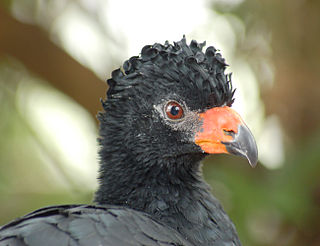
Curassows are one of the three major groups of cracid birds. They comprise the largest-bodied species of the cracid family. Three of the four genera are restricted to tropical South America; a single species of Crax ranges north to Mexico. They form a distinct clade which is usually classified as the subfamily Cracinae.

The Trinidad piping guan locally known as the pawi, is a bird in the chachalaca, guan and curassow family Cracidae, endemic to the island of Trinidad. It is a large bird, somewhat resembling a turkey in appearance, and research has shown that its nearest living relative is the blue-throated piping guan from South America. It is a mainly arboreal species feeding mostly on fruit, but also on flowers and leaves. At one time abundant, it has declined in numbers and been extirpated from much of its natural range and the International Union for Conservation of Nature has rated the bird as "critically endangered".

Crax is a genus of curassows in the order Galliformes, a clade of large, heavy-bodied, ground-feeding birds. They are known from tropical South America with one species, the great curassow, ranging northwards through Central America as far as Mexico. The curassows in this genus are noted for their sexual dimorphism; males are more boldly coloured than females and have facial ornamentation such as knobs and wattles. They are also characterised by curly crests and contrastingly-coloured crissums. Crax curassows probably originated as a distinct lineage during the Late Miocene. During the Messinian, the ancestral Crax split into two lineages separated by the Colombian Andes and the Cordillera de Mérida which uplifted at that time. The northern lineage radiated into the great, blue-billed, and yellow-knobbed curassows, while the four southern species evolved as they became separated by the uplifting of various mountain ranges.

The Cauca guan is a bird in the chachalaca, guan and curassow family, Cracidae.
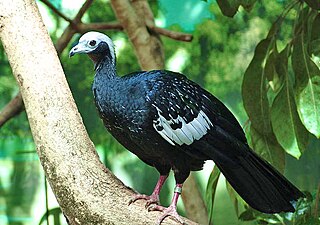
The piping guans are a bird genus, Pipile, in the family Cracidae. A recent study, evaluating mtDNA, osteology and biogeography data concluding that the wattled guan belongs in the same genus as these and is a hypermelanistic piping guan. Thus, Pipile became a junior synonym of Aburria, though this conclusion was not accepted by the South American Checklist Committee, or evaluated by the IOC, so the classification remains in Pipile.

The crested guan is a member of an ancient group of birds of the family Cracidae, which are related to the Australasian mound builders. It is found in the Neotropics, in lowlands forests ranging from south Mexico and the Yucatán Peninsula to western Ecuador and southern Venezuela. The sexes are similar in appearance; the plumage is mainly dark brown with white spotting, an area of bare skin round the eye, bright red wattles, a bushy crest, a long broad tail and pink legs. It is a social bird, often seen in pairs or small family groups. It feeds in trees, mainly on fruit, and builds a nest of twigs on a branch. The two or three white eggs are incubated by the female. The International Union for Conservation of Nature has rated this bird's conservation status as "least concern".
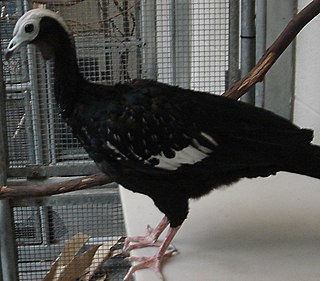
The guans are a number of bird genera which make up the largest group in the family Cracidae. They are found mainly in northern South America, southern Central America, and a few adjacent Caribbean islands. There is also the peculiar horned guan which is not a true guan, but a very distinct and ancient cracid with no close living relatives.

The black-fronted piping guan or jacutinga is a bird in the chachalaca, guan and curassow family Cracidae. This species occurs in Atlantic Forests in south-eastern Brazil and adjacent Argentina and Paraguay. It has become quite rare in recent decades due to hunting and habitat destruction.
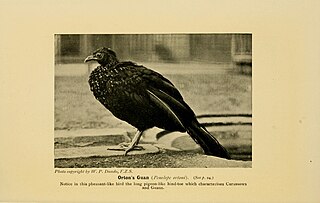
The Baudó guan is a species of bird from the family Cracidae. It is restricted to humid forests in the west Andean foothills of western Colombia and north-western Ecuador. It is highly sensitive to hunting and habitat destruction, with large sections of the main distribution in the Chocó having already disappeared. Consequently, it is considered to be endangered by BirdLife International and IUCN.
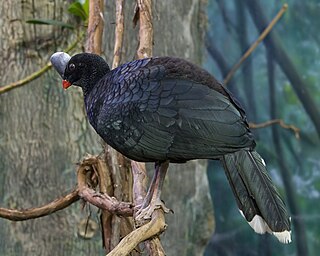
The helmeted curassow or northern helmeted curassow, is a large terrestrial bird in the family Cracidae found in the subtropical cloud-forest in steep, mountainous regions of western Venezuela and northern Colombia. There are two subspecies found in different mountain ranges. It is a mostly black bird with a white tip to its tail, a red bill and a distinctive grey casque on its forehead. The population of this bird is in decline and the International Union for Conservation of Nature has rated its conservation status as "endangered".
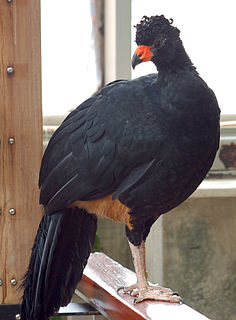
The wattled curassow is a threatened member of the family Cracidae, the curassows, guans, and chachalacas. It is found in remote rainforests in the western Amazon basin in South America. Males have black plumage, except for a white crissum, with curly feathers on the head and red bill ornaments and wattles. Females and juveniles are similar but lack the bill ornamentation and have a reddish-buff crissum area. The wattled curassow is the most ancient lineage of the southern Crax curassows. In captivity, it sometimes hybridises with the blue-billed curassow.

The horned guan is a large, approximately 85 cm (33 in) long, turkey-like bird with glossy black dorsal plumage, red legs, a white iris, a yellow bill, and a red horn on top of its head. The breast and upper belly are white, and its long tail feathers are black with a white band near the base. Both sexes are similar. The young are duller with a smaller horn, and have a brown tail and wings.

The wattled guan is a species of bird in the family Cracidae. It is a fairly large black cracid with blue-based, black-tipped beak and a long, red-and-yellow wattle.

The horned curassow, or southern helmeted curassow, is a species of bird in the family Cracidae found in humid tropical and subtropical forests. It was first described by James Bond and Rodolphe Meyer de Schauensee in 1939 from a specimen collected in Bolivia, and further birds that were described from Peru in 1971 were thought to be a new subspecies. However, the taxonomical position of the birds found in Peru in 1971 is unclear. The horned curassow as originally described is endemic to Bolivia. It is a large, predominantly black bird with a distinctive casque on its forehead. It is an uncommon bird with a limited range and is suffering from habitat loss, and the International Union for Conservation of Nature has rated its conservation status as being "critically endangered".

The bearded guan(Penelope barbata) is a species of bird in the family Cracidae, the chachalacas, guans, and curassows. It is found in Ecuador and Peru. Its natural habitat is subtropical or tropical moist montane forest. It is threatened by habitat loss.

The dusky-legged guan is a species of bird in the family Cracidae, the chachalacas, guans, and curassows. It is found in Uruguay, northeastern Argentina and southernmost areas of Paraguay and Brazil; a narrow disjunct range is in northern Argentina extending into south-central Bolivia.

The highland guan is a species of bird in the family Cracidae. It is found in the highlands of El Salvador, Guatemala, Honduras, southern Mexico, and Nicaragua.
The Sira curassow is a species of bird in the family Cracidae. It is found in the Cerros del Sira in central Peru. Its natural habitat is tropical, moist, montane cloud forest.




























